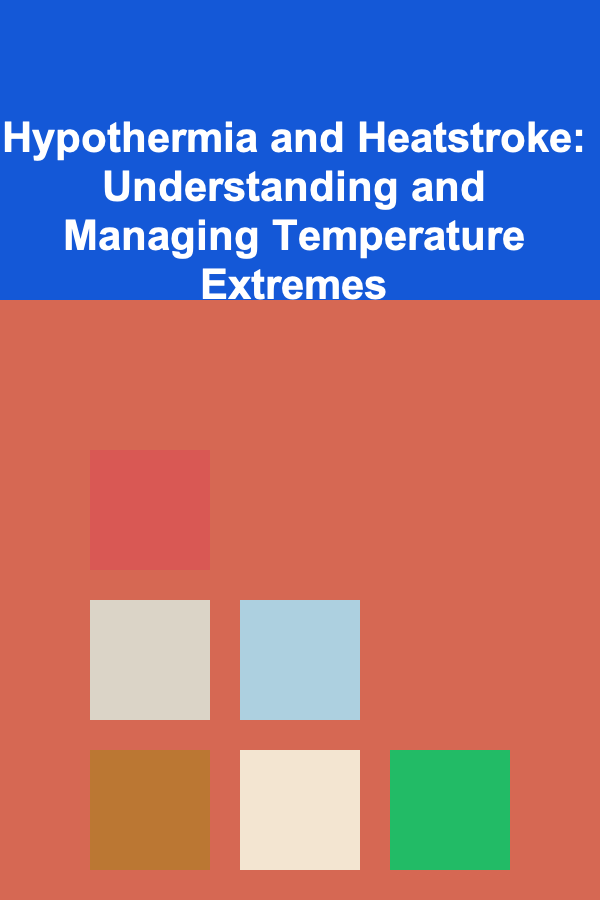
Hypothermia and Heatstroke: Understanding and Managing Temperature Extremes
ebook include PDF & Audio bundle (Micro Guide)
$12.99$10.99
Limited Time Offer! Order within the next:

The human body is remarkably adept at maintaining a stable core temperature, a process known as thermoregulation. However, when exposed to extreme environmental conditions, this system can be overwhelmed, leading to potentially life-threatening conditions like hypothermia and heatstroke. Understanding the causes, symptoms, and appropriate treatments for these conditions is crucial for anyone who spends time outdoors, works in extreme environments, or cares for vulnerable populations.
Hypothermia: When the Body Loses Heat Faster Than It Can Produce It
Understanding Hypothermia
Hypothermia occurs when the body loses heat faster than it can produce it, resulting in a dangerously low body temperature. Normal body temperature is around 98.6°F (37°C). Hypothermia is generally defined as a body temperature below 95°F (35°C). Several factors contribute to heat loss, including:
- Exposure to cold environments: This is the most obvious cause, whether due to outdoor activities in winter, inadequate shelter, or even prolonged exposure to cool temperatures combined with wet clothing.
- Wet clothing: Water conducts heat away from the body much faster than air. Wet clothing significantly accelerates heat loss.
- Wind chill: Wind increases the rate of heat loss through convection.
- Immersion in cold water: This is a particularly dangerous situation, as water rapidly draws heat away from the body.
- Medical conditions: Certain medical conditions, such as hypothyroidism, diabetes, and peripheral neuropathy, can impair the body's ability to regulate temperature.
- Medications: Some medications, such as sedatives, tranquilizers, and beta-blockers, can interfere with thermoregulation.
- Alcohol and drug use: Alcohol and drug use can impair judgment, leading to risky behavior in cold environments, and can also dilate blood vessels, increasing heat loss.
- Age: Infants and elderly individuals are more susceptible to hypothermia due to reduced muscle mass, thinner skin, and impaired thermoregulatory mechanisms.
- Lack of food and hydration: The body needs energy to produce heat. Dehydration can also impair circulation, reducing heat delivery to the extremities.
Stages and Symptoms of Hypothermia
Hypothermia progresses through several stages, each with distinct symptoms:
- Mild Hypothermia (90-95°F / 32-35°C):
- Shivering: This is the body's attempt to generate heat through muscle contractions.
- Rapid breathing and heart rate.
- Fatigue and weakness.
- Confusion and impaired judgment.
- Incoordination.
- Slurred speech.
- Moderate Hypothermia (82-90°F / 28-32°C):
- Violent shivering (may stop in later stages).
- Muscle stiffness.
- Decreased level of consciousness.
- Slow, shallow breathing.
- Slow heart rate.
- Loss of coordination.
- Confusion and disorientation.
- Severe Hypothermia (Below 82°F / 28°C):
- Shivering stops.
- Very slow and shallow breathing.
- Irregular or undetectable heartbeat.
- Loss of consciousness.
- Muscle rigidity.
- Dilated pupils.
- Apparent death. It is crucial to remember that a person with severe hypothermia may appear dead but still be alive. Aggressive treatment is still warranted.
First Aid for Hypothermia
Prompt and appropriate first aid is essential for individuals suffering from hypothermia. The following steps should be taken:
- Call for emergency medical help immediately (911 or your local emergency number). Hypothermia can be life-threatening, and professional medical care is crucial.
- Move the person to a warm, sheltered location. Protect them from further exposure to the cold, wind, and wet.
- Remove any wet clothing. Replace it with dry clothing, blankets, or towels.
- Insulate the person. Wrap them in blankets, sleeping bags, or anything that will provide insulation. Pay particular attention to covering the head, neck, and groin, as these areas are prone to significant heat loss.
- Apply warm compresses to the neck, armpits, and groin. Use warm (not hot) water bottles, heating pads, or towels. These areas have major blood vessels close to the surface of the skin, and warming them can help warm the core body temperature. Avoid applying direct heat to the extremities, as this can cause blood vessels to dilate and draw blood away from the core, potentially worsening the hypothermia.
- If the person is conscious and able to swallow, give them warm, sweet drinks. Avoid caffeine and alcohol, as these can interfere with thermoregulation. Sugary drinks provide quick energy.
- Monitor the person's breathing and heart rate. Be prepared to administer CPR if necessary.
- Handle the person gently. Rough handling can trigger cardiac arrest in severe hypothermia.
- Do not rub or massage the extremities. This can cause tissue damage.
- If far from medical assistance, consider a warm bath. This should be done cautiously, ensuring the water is warm (not hot) and that the person is monitored closely. Immersion in warm water can cause a sudden drop in blood pressure, so it's important to proceed slowly and carefully. Get the person out of the water if they begin to shiver uncontrollably.
Prevention of Hypothermia
Prevention is always better than treatment. Here are some tips to prevent hypothermia:
- Dress in layers. Layers of clothing trap warm air and provide better insulation than a single bulky layer. Choose moisture-wicking fabrics for the inner layers to keep sweat away from the skin.
- Wear a hat and gloves. A significant amount of heat is lost through the head and hands.
- Stay dry. Avoid activities that may get you wet, or bring extra clothing in case you do.
- Seek shelter from the wind and cold. If you are caught in a storm, find a protected area to wait it out.
- Stay hydrated and eat regularly. The body needs energy to produce heat.
- Avoid alcohol and drug use in cold environments.
- Be aware of the weather conditions and plan accordingly. Check the forecast before heading out and be prepared for changing conditions.
- Let someone know your plans and when you expect to be back. This is especially important if you are hiking or engaging in other outdoor activities in remote areas.
- Carry a survival kit with essentials like a first-aid kit, extra clothing, food, water, and a means to start a fire.
Heatstroke: When the Body Overheats
Understanding Heatstroke
Heatstroke is a serious condition that occurs when the body's temperature regulation system fails, and the body overheats. It is the most severe form of heat illness and can be fatal if not treated promptly. Heatstroke typically occurs when the body temperature reaches 104°F (40°C) or higher.
There are two main types of heatstroke:
- Exertional heatstroke: This occurs in otherwise healthy individuals who are engaging in strenuous physical activity in hot, humid weather. It is common among athletes, soldiers, and outdoor workers.
- Non-exertional (classic) heatstroke: This typically affects elderly individuals, young children, and people with chronic illnesses. It often occurs during heat waves when the body is unable to cope with prolonged exposure to high temperatures.
Factors that increase the risk of heatstroke include:
- High ambient temperature: The hotter the environment, the harder it is for the body to dissipate heat.
- High humidity: Humidity reduces the effectiveness of sweating, the body's primary cooling mechanism.
- Strenuous physical activity: Exercise increases heat production.
- Dehydration: Dehydration reduces the body's ability to sweat.
- Age: Infants and elderly individuals are more vulnerable to heatstroke.
- Medical conditions: Certain medical conditions, such as heart disease, lung disease, diabetes, and obesity, can increase the risk of heatstroke.
- Medications: Some medications, such as diuretics, beta-blockers, and antihistamines, can interfere with thermoregulation.
- Alcohol and drug use: Alcohol and drug use can impair judgment and increase the risk of dehydration.
- Sunburn: Sunburn impairs the skin's ability to regulate temperature.
- Wearing heavy or restrictive clothing: Clothing that traps heat can increase the risk of heatstroke.
Symptoms of Heatstroke
The symptoms of heatstroke can vary, but common signs include:
- High body temperature: A core body temperature of 104°F (40°C) or higher is a hallmark of heatstroke.
- Altered mental status: This can include confusion, disorientation, agitation, seizures, or loss of consciousness.
- Hot, dry skin: In classic heatstroke, the skin may be hot and dry, as sweating has stopped. However, in exertional heatstroke, the skin may be moist from exertion.
- Rapid, shallow breathing.
- Rapid, strong heartbeat. This can weaken later.
- Headache.
- Nausea and vomiting.
- Muscle cramps or weakness.
- Dizziness.
- Seizures.
- Coma.
First Aid for Heatstroke
Heatstroke is a medical emergency. Immediate and aggressive treatment is crucial to prevent permanent organ damage or death. The following steps should be taken:
- Call for emergency medical help immediately (911 or your local emergency number).
- Move the person to a cool, shaded location.
- Remove any excess clothing.
- Aggressively cool the person. There are several ways to do this:
- Immerse the person in a cold water bath. This is the most effective method, if possible.
- Spray the person with cool water and fan them. This promotes evaporative cooling.
- Apply ice packs to the neck, armpits, and groin. These areas have major blood vessels close to the surface of the skin.
- Place wet towels or cloths on the person's skin.
- Monitor the person's body temperature. Continue cooling efforts until the body temperature reaches 101-102°F (38.3-38.9°C).
- If the person is conscious and able to swallow, give them cool water or electrolyte drinks. Avoid sugary drinks, as they can worsen dehydration.
- Monitor the person's breathing and heart rate. Be prepared to administer CPR if necessary.
- Do not give the person any medications, such as aspirin or acetaminophen. These medications will not help lower the body temperature and may be harmful.
Prevention of Heatstroke
Preventing heatstroke is crucial, especially during hot weather. Here are some tips:
- Stay hydrated. Drink plenty of fluids, especially water or electrolyte drinks, throughout the day. Avoid sugary drinks, alcohol, and caffeine.
- Avoid strenuous activity during the hottest part of the day. If you must exercise, do so in the early morning or late evening.
- Wear lightweight, loose-fitting clothing. Choose light-colored clothing that reflects heat.
- Take frequent breaks in cool, shaded areas.
- Never leave children or pets in a parked car. The temperature inside a car can rise rapidly, even on a mild day.
- Be aware of the signs and symptoms of heat exhaustion and heatstroke.
- Acclimatize to the heat gradually. If you are not used to hot weather, gradually increase your exposure over several days or weeks.
- Monitor weather forecasts and heed heat advisories.
- Check on elderly individuals and other vulnerable people during heat waves.
Distinguishing Between Hypothermia and Heatstroke
While seemingly opposite conditions, confusion can arise in distinguishing between hypothermia and heatstroke, especially when a person is found unconscious. Here's a table summarizing the key differences, remembering that obtaining a core body temperature is critical for definitive diagnosis.
| Characteristic | Hypothermia | Heatstroke | |---------------------------|--------------------------------------------------------------------|----------------------------------------------------------------------------------------------------| | Core Body Temperature | Below 95°F (35°C) | Above 104°F (40°C) | | Shivering | Present in mild to moderate stages (may be absent in severe cases) | Usually absent (muscle cramps may occur) | | Skin | Cold to the touch, pale, or bluish | Hot to the touch; may be dry or moist | | Mental Status | Confusion, impaired judgment, drowsiness, loss of consciousness | Confusion, disorientation, agitation, seizures, loss of consciousness | | Breathing | Slow, shallow | Rapid, shallow | | Heart Rate | Slow | Rapid initially, may become weak and rapid later | | Sweating | May be present initially, but decreases as hypothermia progresses | May be absent (especially in classic heatstroke), or profuse (especially in exertional heatstroke) | | Pupils | Dilated | Dilated | | Typical Environment | Cold, wet, windy conditions | Hot, humid conditions |
Special Considerations: Vulnerable Populations
Certain populations are at a higher risk for both hypothermia and heatstroke. It's crucial to be especially vigilant and proactive in protecting these groups.
Infants and Young Children
Infants and young children have a higher surface area-to-volume ratio than adults, making them lose heat more rapidly in cold environments and overheat more quickly in hot environments. They also have less developed thermoregulatory systems. Parents and caregivers should:
- Dress infants and children appropriately for the weather, using layers in cold weather and light, loose-fitting clothing in hot weather.
- Monitor their temperature regularly, especially during extreme weather conditions.
- Ensure adequate hydration.
- Never leave children unattended in a car, even for a short period.
Elderly Individuals
Elderly individuals often have impaired thermoregulatory mechanisms, reduced muscle mass, and chronic medical conditions that increase their risk for both hypothermia and heatstroke. They may also be less likely to recognize the symptoms of these conditions. Family members and caregivers should:
- Check on elderly individuals regularly, especially during extreme weather conditions.
- Ensure they have adequate heating and cooling in their homes.
- Encourage them to stay hydrated and eat regularly.
- Help them dress appropriately for the weather.
- Be aware of any medications they are taking that may interfere with thermoregulation.
Individuals with Chronic Medical Conditions
Certain medical conditions, such as heart disease, lung disease, diabetes, and obesity, can impair the body's ability to regulate temperature. Individuals with these conditions should:
- Work with their healthcare providers to manage their conditions and minimize their risk for hypothermia and heatstroke.
- Be extra cautious during extreme weather conditions.
- Follow their doctor's recommendations for hydration and medication use.
Disclaimer: This information is for general knowledge and informational purposes only, and does not constitute medical advice. It is essential to seek the advice of a qualified healthcare professional for any health concerns or before making any decisions related to your health or treatment. Always prioritize seeking professional medical attention in cases of suspected hypothermia or heatstroke.

How to Avoid Common Mistakes as a New Landlord
Read More
How to Build a Membership Recruitment Checklist for Your Environmental Organization: A Detailed Actionable Guide
Read More
How to Keep Your Home Calm During Pet Storm Anxiety
Read More
Smart Shopping: Saving Money on Kids' Clothing and Getting More for Less
Read More
Strategic Operations Leadership: A Guide for Operations Directors
Read More
How To Create a Print-Rich Environment at Home
Read MoreOther Products

How to Avoid Common Mistakes as a New Landlord
Read More
How to Build a Membership Recruitment Checklist for Your Environmental Organization: A Detailed Actionable Guide
Read More
How to Keep Your Home Calm During Pet Storm Anxiety
Read More
Smart Shopping: Saving Money on Kids' Clothing and Getting More for Less
Read More
Strategic Operations Leadership: A Guide for Operations Directors
Read More